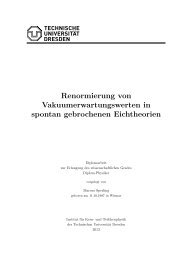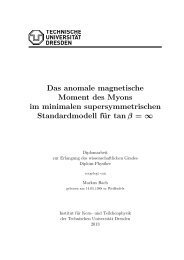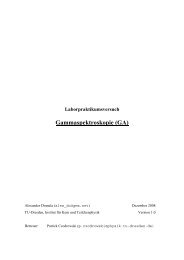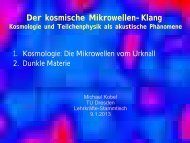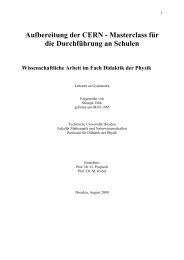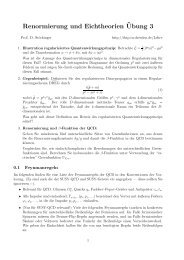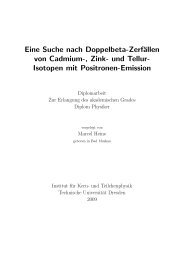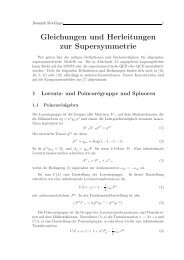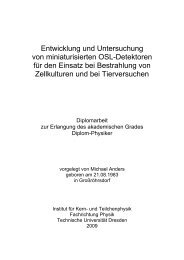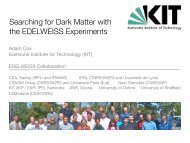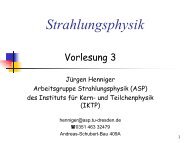a design study for a cobra upgrade to - Institut für Kern- und ...
a design study for a cobra upgrade to - Institut für Kern- und ...
a design study for a cobra upgrade to - Institut für Kern- und ...
Create successful ePaper yourself
Turn your PDF publications into a flip-book with our unique Google optimized e-Paper software.
4.2 Detec<strong>to</strong>r assembly 41<br />
4.2 Detec<strong>to</strong>r assembly<br />
The other important component of a scintillation detec<strong>to</strong>r is the electronic<br />
readout. It converts the part of the scintillation light that reaches<br />
the device, typically just a few h<strong>und</strong>red pho<strong>to</strong>ns, in<strong>to</strong> a usable electric<br />
signal. This can be done with pho<strong>to</strong>multiplier tubes or diodes. In<br />
the following section, possible devices are introduced, afterwards the<br />
aspects of detec<strong>to</strong>r mounting and the light collection are discussed in<br />
section 4.2.2—“Detec<strong>to</strong>r mounting” and finally the energy resolution of<br />
scintilla<strong>to</strong>r is discussed in section 4.2.3—“Energy resolution”.<br />
4.2.1 Electronic readout devices<br />
PHOTO MULTIPLIER TUBES (PMTs) are evacuated glass or metal tubes,<br />
consisting of a front glass with pho<strong>to</strong>cathode, followed by the dynode<br />
string that multiplies the pho<strong>to</strong>electron (electron cascade) and an anode<br />
that collects the multiplied electrons. The final PMT signal is proportional<br />
<strong>to</strong> the number of incident pho<strong>to</strong>ns, until a saturation at high<br />
pho<strong>to</strong>n fluxes.<br />
Roughly every fourth initial pho<strong>to</strong>n that hits the pho<strong>to</strong>cathode produces<br />
a pho<strong>to</strong>electron. In this case the initial pho<strong>to</strong>n is absorbed by<br />
the cathode material and its energy is transferred <strong>to</strong> the a<strong>to</strong>mic electrons.<br />
The electrons can then migrate <strong>to</strong>wards the surface and escape<br />
from the pho<strong>to</strong>cathode if their energy is higher than the work function<br />
of the material. Higher quantum efficiencies are achieved with cathode<br />
materials that have a negative electron affinity (see Knoll [29] p. 271).<br />
The quantum efficiency of modern pho<strong>to</strong>cathodes, which is the ratio of<br />
emitted pho<strong>to</strong>electron per incident pho<strong>to</strong>n, is 20 <strong>to</strong> 30 %. It is mainly<br />
limited by the escape width of the pho<strong>to</strong>electrons, because pho<strong>to</strong>cathodes<br />
of this thickness are still semitransparent <strong>for</strong> pho<strong>to</strong>ns.<br />
The resolution of PMTs can be limited <strong>for</strong> low count rates by dark current.<br />
At room temperature 10 6 −10 8 electrons per m 2 s are emitted from<br />
the pho<strong>to</strong>cathode. This number increases with temperature. Especially<br />
large diameter PMTs can have less resolution due <strong>to</strong> variations of the<br />
thickness of the pho<strong>to</strong>cathode. The quantum efficiency also depends<br />
on the wavelength of the incident pho<strong>to</strong>n. The detection of pho<strong>to</strong>ns<br />
with long wavelength is limited by the height of the potential barrier<br />
and at short wavelength by the opacity of the entrance window material.<br />
The cut-off lies <strong>for</strong> glass at 350 nm and <strong>for</strong> fused silica or quartz<br />
at 160 nm. This is shown in figure 4.10. Multialkali (Na2KSb) cathodes



